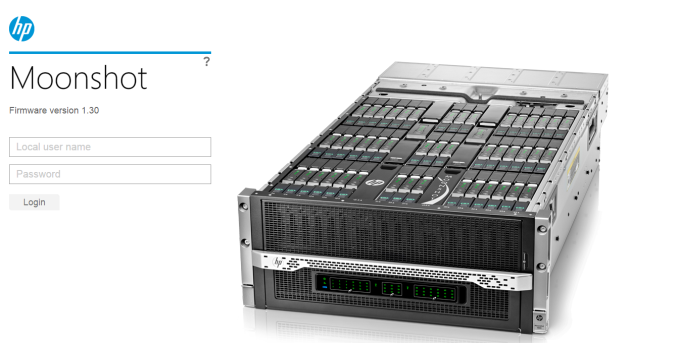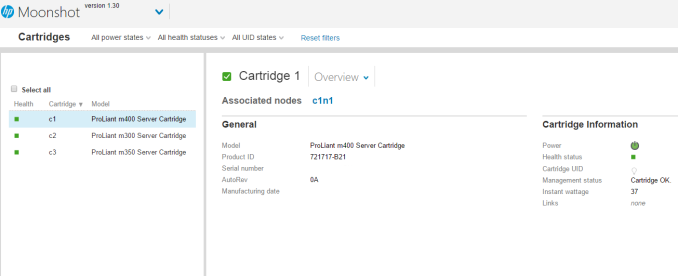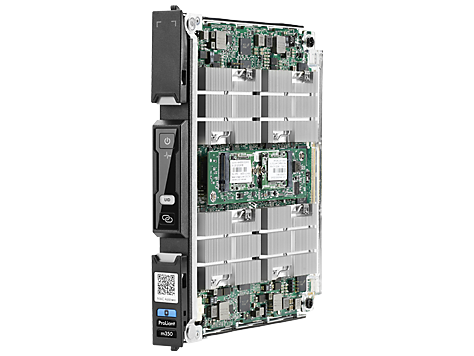X-Gene 1, Atom C2000 and Xeon E3: Exploring the Scale-Out Server World
by Johan De Gelas on March 9, 2015 2:00 PM ESTHP Moonshot
We discussed the HP Moonshot back in April 2013. The Moonshot is HP's answer to SeaMicro's SM15000: a large 4.3U chassis with no less than 45 cartridges that share three different fabrics: network, storage, and clustering. Each cartridge can contain one to four micro servers or "nodes". Just like a blade server, cooling (five fans), power (four PSUs), and uplinks are shared.
Back in April 2013, the only available cartridge was based on the anemic Atom S1260, a real shame for such an excellent chassis. Since Q4 2014, HP now offers six different cartridges ranging from the Opteron X2150 (m700) to the rather powerful Xeon E3-1284Lv3 (m710). The different models are all tailored to specific workloads. The m700 is meant to be used in a Citrix virtual desktop environment while the m710 is targeted at video transcoding. We tested the m400 (X-Gene 2.4), m300 (Atom C2750), and m350 (four Atom C2730 nodes) cartridges.
The m400 is the first server we have seen that uses the 64-bit ARMv8 AppliedMicro X-Gene. HP positions the m400 as the heir of mobile computing, and touts its energy efficiency. Other differentiators are memory bandwidth and capacity. The X-Gene has a quad-channel memory controller and as a result is the only cartridge with eight DIMMs. We were very interested in understanding how X-Gene would compare to the Intel Xeons. HP positions the m400 as the micro server for web caching (memcached) and web applications (LAMP). The m400 also comes with beefy storage: you can order a 480GB SSD with a SATA or M.2 interface.
The m300 cartridge is based on the Atom C2750 with support for up to 32GB of RAM. HP positions this cartridge as "web infrastructure in a box". The m400 is mostly about web caching and the web front-end while the m300 seems destined to run the complete stack (front- and back-end). However, it is clear that there is some overlap between the m300 and m400 as there's nothing to stop you from running a complete "web infrastructure" on the m400 if it runs well in 32GB or less.
The m350 cartridge is all about density: you get four nodes in one cartridge. There is a trade-off however: you are limited to 16GB of RAM and can only use M.2 flash storage, limited to 64GB.
Each node of the m350 is powered by one of Intel's most interesting SKUs, the 1.7GHz 8-core Atom C2730 that has a very low 12W TDP. The m350 is positioned as a way to offer managed hosting on physical (as opposed to virtualized) servers in a cost effective way.













47 Comments
View All Comments
gdansk - Monday, March 9, 2015 - link
xgene is not looking so great. Even if it is 50% more efficient as they promise they'll still be behind Atom.Samus - Monday, March 9, 2015 - link
HP Moonshot chassis are still *drool*Krysto - Monday, March 9, 2015 - link
The main problem with the non-Intel systems is not only that they use older processes compared to Intel, but that they use older processes even compared to the rest of the non-Intel chip industry. AMD is typically always behind 1 process node among non-Intel chip makers. If they'd at least use the cutting edge processes as they become available from non-Intel processes, maybe they'd stand a chance, especially now that the gap in process technologies is shrinking.Samus - Monday, March 9, 2015 - link
AMD simply isn't as bad as people continually make them out to be. Yes, they're "behind" Intel but it's all in the approach. We are talking about two engineering houses that share nothing in common but a cross licensing agreement. AMD has very competitive CPU's to Intel's i5's for nearly half the price, but yes, they use more power (at times 1/3 more.)But facts are facts: AMD is the second high-tech CPU manufacture in the world. Not Qualcomm, not Samsung. It's pretty obvious AMD engineering talent spreads more diversity than anyone other than Intel, and potentially superior to Intel on GPU design (although this has obviously been shifting over the years as Intel hires more "GPU talent.")
AMD in servers is a hard pill to swallow though. If purchasing based on price alone, it can be a compelling alternative, but for rack space or low-energy computing?
Taneli - Tuesday, March 10, 2015 - link
AMD doesn't even make it in top 10 semiconductor companies in sales. Qualcomm is three, Samsung semicondutors six and Intel almost ten times the size of AMD.Outside of the gaming consoles they are being completely overrun by competition.
owan - Tuesday, March 10, 2015 - link
I'm sorry, at one point I was an AMD fanboy, back when they actually deserved it based on their products, but you just sound like an apologist. Facts are the facts, FX processors aren't competitive with i5's in performance or power or performance/$ because they get smacked so hard they can't be cheap enough to make up for it. Their CPU designs are woefully out of date, their APU's are bandwidth starved and use way too much power to be useful in the one place they'd be great (mobile), and their lagging process tech means theres not much better coming on the horizon. I don't want to see them go, but at the rate ARM is eating up general computing share, it won't be long before AMD becomes completely irrelevant. It will be Intel vs. ARM and AMD will be an afterthought.xenol - Wednesday, March 11, 2015 - link
Qualcomm is used in pretty much used in most cell phones in the US to the point you'd think Qualcomm is the only SoC manufacturer. I'm pretty sure that's also how it looks in most of the other markets as Korea. Plus even if their SoCs aren't being used, they're modems are heavily used.If anything, Qualcomm is bigger than AMD. Or rather, Qualcomm is the Intel of the SoC market.
xenol - Wednesday, March 11, 2015 - link
[Response to myself since I can't edit]Qualcomm's next major competitor is Apple. But that's about it.
Also I meant to say other markets except Korea.
CajunArson - Monday, March 9, 2015 - link
Bear in mind that the Atom parts were commercially available in 2013, so they are by no means brand-new technology and the 14nm Atom upgrades will definitely help power efficiency even if raw performance doesn't jump a whole lot.Anandtech is also a bit behind the curve because Intel is about to release Xeon-D (8 Broadwell cores and integrated I/O in a 45 watt TDP, or lower), which is designed for exactly this type of workload and is going to massively improve performance in the low-power envelope sphere:
http://techreport.com/review/27928/intel-xeon-d-br...
SarahKerrigan - Monday, March 9, 2015 - link
14nm server Atom isn't coming.http://www.eetimes.com/document.asp?doc_id=1325955
"Atom will become a consumer only SoC."